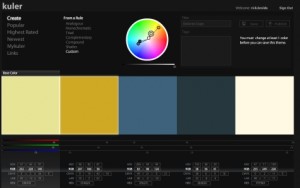 While some people thrive on their monochromatic dreams, I’d venture to say that most of us love the beauty of a colorful world, and even though there is undeniable beauty in classic black and white photography, swashes of color on other photographs really can make for the most fun, eye-catching graphic designs. However, while coming up with your very own, personalized color palettes can be fun, it also can be incredibly time consuming; and if there’s anything we try not to waste, it’s time (well, that and money…). This is where graphic designing tool Kuler comes into the picture.
While some people thrive on their monochromatic dreams, I’d venture to say that most of us love the beauty of a colorful world, and even though there is undeniable beauty in classic black and white photography, swashes of color on other photographs really can make for the most fun, eye-catching graphic designs. However, while coming up with your very own, personalized color palettes can be fun, it also can be incredibly time consuming; and if there’s anything we try not to waste, it’s time (well, that and money…). This is where graphic designing tool Kuler comes into the picture.
Hosted by Adobe, Kuler is a graphic designer’s dream. Available online at no charge, Kuler allows users to create their own color palettes, share them with others, and view other graphic designer’s contribution to the palette pool. Users, however, must have an Adobe ID to fully access and enjoy all of the features of Kuler.
The organization of the Kuler palettes might be a bit frustrating for anyone who is looking for a particular shade/hue-based theme, but pleasant for anyone who wants to randomly wander across an exciting new palette idea. Browsing is accomplished through tabs such as “newest,†“most popular,†“highly rated,†and “random.†While “most popular†and “highly rated†might sound like synonyms to those unfamiliar with the site, they are actually fairly different; the “most popular†themes are those downloaded with the highest frequency, and the “highly rated†themes are those receiving the highest average reviews from other users.
However, one of the most fun features of Kuler is that designers can name all of their own color palettes, and as such, many of the themes have wonderfully creative names. Almost as lovely as the themes themselves, names such as “Tastebud Tickle,†“Jamais desesperer,†and “Bramble†are sure to inspire any designer to create beautiful works. (On the other hand, a palette by the name of “Don’t Pee In the Pool†is guaranteed to make anyone remember to laugh a little on the job.)
Overall, Kuler should prove a valuable tool to any graphic designer who has the time to leisurely browse through color palettes for inspiration. While it probably won’t save a designer too much time if he is looking for a specific color pattern for a project, it should still be a nice tool to have in the back of a designer’s inspiration weapons, as a means to continue the creation of creative color pairings.

